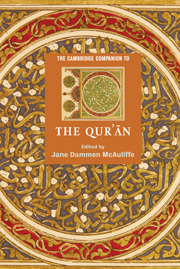Book contents
- Frontmatter
- Introduction
- Part I Formation of the Qur'ānic text
- Part II Description and analysis
- Part III Transmission and dissemination
- 7 From palm leaves to the Internet
- 8 Inscriptions in art and architecture
- Part IV Interpretations and intellectual traditions
- Part V Contemporary readings
- Qur'ān Citation Index
- General Index
8 - Inscriptions in art and architecture
from Part III - Transmission and dissemination
Published online by Cambridge University Press: 28 March 2007
- Frontmatter
- Introduction
- Part I Formation of the Qur'ānic text
- Part II Description and analysis
- Part III Transmission and dissemination
- 7 From palm leaves to the Internet
- 8 Inscriptions in art and architecture
- Part IV Interpretations and intellectual traditions
- Part V Contemporary readings
- Qur'ān Citation Index
- General Index
Summary
Qur'ānic inscriptions are ubiquitous, found on buildings and objects produced in many media throughout the Islamic lands from the earliest times to the present. The first example of Islamic architecture, the Dome of the Rock built by the Umayyad caliph 'Abd al-Malik (r. 65-86/685-705) in Jerusalem in 72/692, is decorated with a long band of Qur'ānic verses. So are many recent buildings, such as the mosque built in 1983 at the King Khaled International Airport north of Riyadh. These Qur'ānic inscriptions are, quite naturally, used more frequently in religious settings, especially mosques and their furnishings. But they were not exclusive to such sites, and buildings like the Alhambra Palace in Granada also bear Qur'ānic inscriptions deemed suitable for a ceremonial setting. Nevertheless, Qur'ānic inscriptions were not commonly found in utilitarian contexts, where the mundane function of the object might compromise the sanctity of the text. Despite their ubiquity, the study of Qur'ānic inscriptions is a relatively new field, and this chapter begins with a survey of the subject and its history before turning to the question of how and why patrons and artisans selected specific Qur'ānic texts and adapted their form to decorate these myriad objects.
- Type
- Chapter
- Information
- The Cambridge Companion to the Qur'ān , pp. 163 - 178Publisher: Cambridge University PressPrint publication year: 2006
- 3
- Cited by



